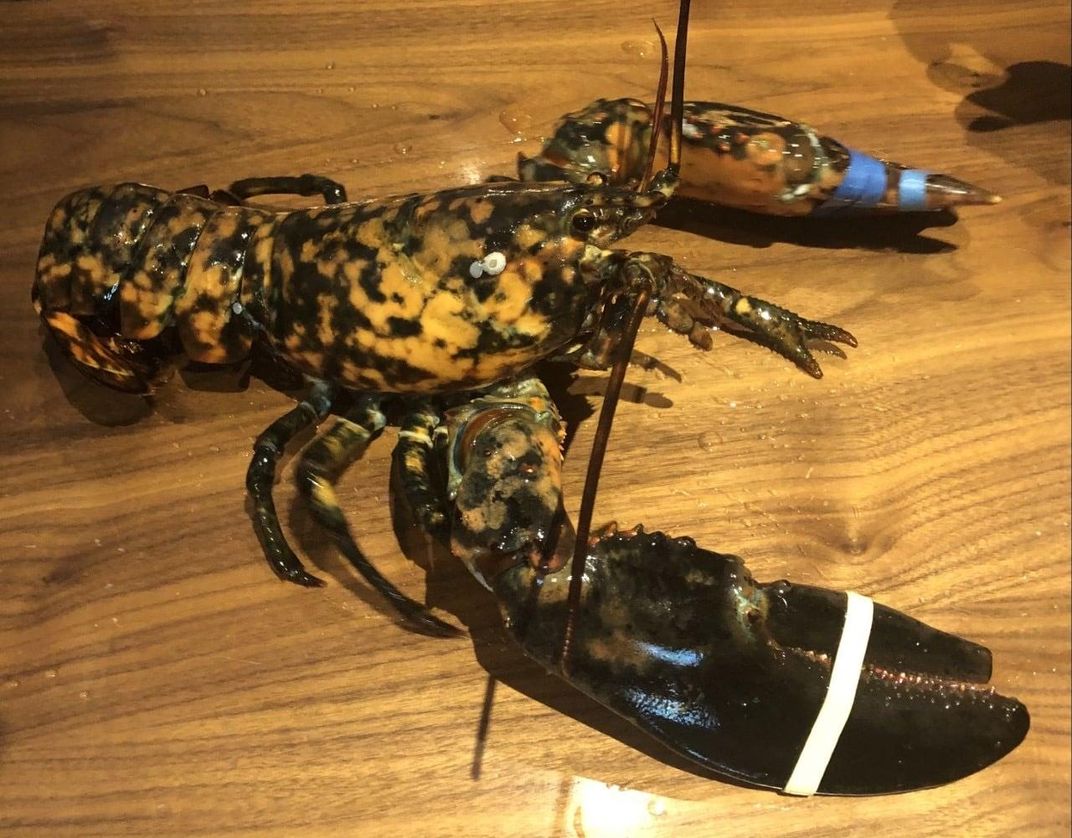Virginia Museum Rescues ‘Freckles’ the Calico Lobster From the Dinner Menu
Most lobsters are brown, but about one in 30 million of the crustaceans are calico-colored
/https://tf-cmsv2-smithsonianmag-media.s3.amazonaws.com/filer/68/fd/68fd76b1-dade-4595-b5e6-2b37ee716937/12-freckles1.jpeg)
Late last month, workers at a Red Lobster Seafood Restaurant in Manassas, Virginia, found a spectacularly speckled crustacean in their usual shipment. Most lobsters are a muddy brown color, but this large male looked like its shell had been splatter-painted with bright orange.
Employees at the restaurant recognized the rarity of the lobster’s shell, named him Freckles and reached out to the Red Lobster support team to make a rescue plan, reports Alaa Elassar for CNN. The company then contacted the Akron Zoo in Ohio for advice because the zoo had taken in a blue lobster named Clawdia last year, per Mike Pomranz at Food & Wine.
The zoo helped the restaurant find a local rescue option: the Virginia Living Museum in Newport News on the Virginia Peninsula. The museum’s senior director of animal welfare and conservation Chris Crippen and aquarium curator Patrycja Lawryniuk picked up Freckles on April 29, the museum wrote on Facebook.
"Calico-colored lobsters like Freckles are so rare, it was almost unbelievable that we received one," said a Red Lobster spokesperson to CNN. "We are so proud of our employees for recognizing that Freckles was so special—and for reaching out so we could make arrangements for rescue."
As a calico lobster, Freckles is a one-in-30-million find. Calico lobsters aren’t quite as rare as all-white “ghost” lobsters, which make up about one-in-100-million lobsters. But it’s much rarer than blue lobsters, which make up about one in five million of the critters, according to the New England Aquarium.

Because close to 525 million lobsters are caught each summer in Maine alone, there are “plenty of opportunity for lobstermen” to snag an unusual catch, says University of Maine marine ecologist Robert Steneck to the Washington Post’s Paulina Firozi.
Often, lobstermen will return their unusual finds to the sea rather than include them with the day’s catch.
“They’re conservationists, the lobstermen,” says New Hampshire invertebrate zoologist Ellen Goethel to the Washington Post. “It shows the great deal of respect the fisherman have for the ocean, the fact that they’re willing to give up a piece of their livelihood.”
But often, fishermen and restaurants make calls to local oceanariums, aquariums, zoos and museums looking for a suitable refuge for their find. So many blue lobsters that aren’t outstandingly vibrant are turned away by the New England Aquarium in Boston, spokesperson Tony LaCasse told Boston.com’s Nik DeCosta-Klipa in 2017. (The aquarium rescued a calico lobster named Calvin in 2012.)
Lobster shells have three layers with different pigments: the top layer is yellow, the middle is blue and red is at the bottom, explained Anita Kim to Boston.com, but “our eyes can’t handle the layers and so we see brown.”
When a lobster lands in a pot of boiling water, the chemicals in its yellow and blue layers fall apart. Only the red pigment survives the heat, which is why cooked lobsters are bright red.
The exact factors that cause lobster shells to take on unusual hues aren’t yet understood, but both diet and genetics play a role. But bright colors make lobsters a relatively easy target for predators since they stand out from their surroundings, so by the time an animal reaches a restaurant, it’s earned a cushy life in a well-kept tank.
After a 30-day quarantine and a health evaluation, Freckles will join the Virginia Living Museum’s lobster display.
“We take great pride in our conservation efforts and strive to create strong partnerships in our community. Red Lobster reached out to the AZA network – of which we are a proud member – to provide a home for this rare and beautiful animal,” said Crippen in a museum statement. “We see this as an opportunity to share nature’s anomaly with guests, as well as continue important education about sustainable seafood practices and significant conservation efforts of the American lobster fishery.”